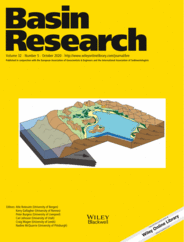
Full text loading...
 , Conrad Childs1,2, Patrick M. Shannon1,3, John J. Walsh1,2
, Conrad Childs1,2, Patrick M. Shannon1,3, John J. Walsh1,2
The Celtic Sea basins lie on the continental shelf between Ireland and northwest France and consist of a series of ENE–WSW trending elongate basins that extend from St George’s Channel Basin in the east to the Fastnet Basin in the west. The basins, which contain Triassic to Neogene stratigraphic sequences, evolved through a complex geological history that includes multiple Mesozoic rift stages and later Cenozoic inversion. The Mizen Basin represents the NW termination of the Celtic Sea basins and consists of two NE–SW‐trending half‐grabens developed as a result of the reactivation of Palaeozoic (Caledonian, Lower Carboniferous and Variscan) faults. The faults bounding the Mizen Basin were active as normal faults from Early Triassic to Late Cretaceous times. Most of the fault displacement took place during Berriasian to Hauterivian (Early Cretaceous) times, with a NW–SE direction of extension. A later phase of Aptian to Cenomanian (Early to Late Cretaceous) N–S‐oriented extension gave rise to E–W‐striking minor normal faults and reactivation of the pre‐existing basin bounding faults that propagated upwards as left‐stepping arrays of segmented normal faults. In common with most of the Celtic Sea basins, the Mizen Basin experienced a period of major erosion, attributed to tectonic uplift, during the Paleocene. Approximately N–S Alpine regional compression‐causing basin inversion is dated as Middle Eocene to Miocene by a well‐preserved syn‐inversion stratigraphy. Reverse reactivation of the basin bounding faults was broadly synchronous with the formation of a set of near‐orthogonal NW–SE dextral strike‐slip faults so that compression was partitioned onto two fault sets, the geometrical configuration of which is partly inherited from Palaeozoic basement structure. The segmented character of the fault forming the southern boundary of the Mizen Basin was preserved during Alpine inversion so that Cenozoic reverse displacement distribution on syn‐inversion horizons mirrors the earlier extensional displacements. Segmentation of normal faults therefore controls the geometry and location of inversion structures, including inversion anticlines and the back rotation of earlier relay ramps.
,Reverse displacements during inversion mirror normal displacements during extension. Inversion occurred by coeval reverse reactivation of normal faults and dextral strike‐slip faulting. The throw profiles are stepped where they intersect the larger strike‐slip faults increases in throw across the branchpoints with the dextral strike‐slip faults.

Article metrics loading...

Full text loading...
References


Data & Media loading...

